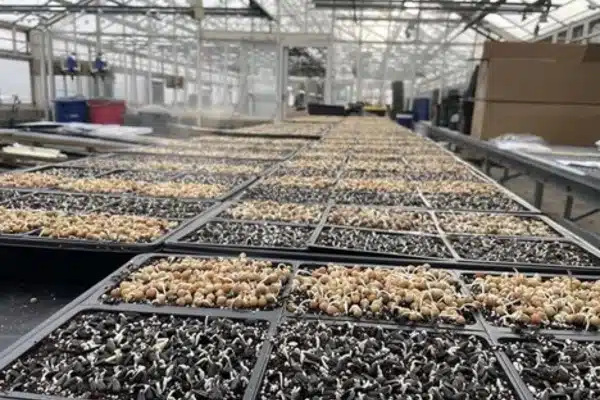Biofortification of microgreens with zinc is a promising strategy for addressing global “hidden hunger.” Hidden hunger is defined as a chronic deficiency of essential micronutrients such as vitamins and minerals despite adequate calorie intake. One of the most common forms of hidden hunger, zinc deficiency, affects millions of people worldwide, particularly in developing countries.
When the seeds of plants like peas and sunflowers are biofortified with zinc, the seedlings that grow quickly and are harvested as microgreens could help to alleviate global malnutrition while also increasing the chances of people surviving a disaster.
This is the conclusion of a Penn State research team that experimented with various biofortification methods to determine the most effective way to incorporate a mineral essential to human health into young plants without reducing the amounts of other essential nutrients they produce. According to team leader Francesco Di Gioia, assistant professor of vegetable crop science, microgreens biofortified with zinc provide people with a lifeline in the face of starvation risk.
“This study has demonstrated that zinc biofortification through seed nutri-priming achieves needed zinc levels in the young pea and sunflower plants we focused our experiments on,” he said. “These findings have implications for both global ‘hidden hunger’ and disaster or emergency preparedness.”
Our work shows microgreens can help people to survive a global catastrophe such as all-out nuclear war, a large asteroid strike or supervolcano eruption in the short term, but additional nutritional resources may be needed in the longer term.
Francesco Di Gioia
The research is part of the ongoing project “Food Resilience in the Face of Catastrophic Global Events,” which is supported by the nonprofit foundation Open Philanthropy. An international team of researchers discovered that microgreens can be grown in a variety of soilless production systems in small spaces indoors, with or without artificial lighting, in Di Gioia’s work. A significant new innovation is the zinc biofortification component.
Di Gioia defined biofortification as the process of growing crops to increase nutritional value from seed to harvest. It differs from food fortification, which involves adding nutrients to foods after they have been harvested. Simply soaking seeds in a zinc solution is a practical and effective strategy for producing nutrient-dense microgreens in poor regions of the world, he pointed out.
“Starting decades ago as fashionable, high-value gourmet greens, microgreens today have gained popularity among consumers for their nutritional profile and high content of antioxidant compounds,” he said. “Our work shows microgreens can help people to survive a global catastrophe such as all-out nuclear war, a large asteroid strike or supervolcano eruption in the short term, but additional nutritional resources may be needed in the longer term.”

A cataclysmic event of this magnitude would jeopardize agricultural productivity by reducing sunlight and temperature, disrupting rainfall patterns, and contaminating water supplies, threatening survivors of the initial event with starvation. Initially, biofortified microgreen production could increase the likelihood of human survival under these conditions.
Pradip Poudel, the second-year doctoral student in the College of Agricultural Sciences who led the research, is excited about the prospect of being able to quickly alleviate hidden hunger. He proposed that growing nutrient-dense crops with agronomic biofortification techniques is a long-term strategy for combating malnutrition.
The World Health Organization defines “hidden hunger” as a lack of vitamins and minerals that occurs when the quality of food people eat does not meet the nutrient requirements they need for their growth and development, Poudel noted. Two billion people suffer from vitamin and mineral deficiencies, according to the WHO.
“We were thinking, how can we increase the content of zinc in microgreens, developing a very simple way that people could use at home in a ‘microgreens growing kit’ that could be delivered in an emergency situation,” he said. “And we know it will be important to include a fertilizer source for zinc so people will just have to soak the seeds before putting them in germination — a very simple process that anyone can do to enrich their microgreens with zinc.”
The researchers reported in Frontiers in Plant Science that zinc sulfate, which is sometimes taken as a dietary supplement to treat a zinc deficiency or to promote wellness, was the most effective zinc source. Zinc accumulation was higher in peas (126%) and sunflower microgreens (230%) after seeds were soaked in a 200 parts per million solution of zinc sulphate.
The researchers looked at how different zinc sources and soaking concentrations affected microgreen yield components like mineral content, phytochemical constituents like total chlorophyll, carotenoids, flavonoids, anthocyanin, and total phenolic compounds, antioxidant activity, and antinutrient factors like phytic acid.
The researchers noted that seed soaking in zinc sulfate and zinc oxide solutions at higher concentrations reduced phytic acid in both pea and sunflower microgreens, which was a positive development. Because phytic acid is a “anti-nutrient,” its lower level suggests that zinc may be more bioavailable, or nutritionally available, to consumers.
Poudel clarified that while microgreens and sprouts are similar, they are not the same thing. Both are baby plants that can be grown indoors and are grown from the same seeds. The similarities, however, end there.















